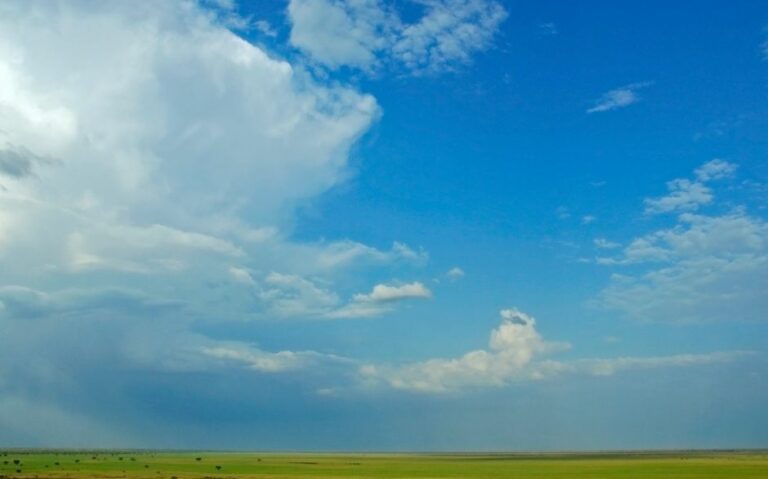By John Florentin Bogne
Introduction

Climate change is an increasingly pressing challenge for many developing countries, such as Cameroon in Central Africa. This phenomenon has led to disproportionate consequences in these regions. Developing countries are more vulnerable to the effects of climate change due to their limited ability to adapt to disruptions of this nature. Cameroon is vulnerable to this change because of its geography and dependence on agriculture. Floods, droughts and rising sea levels, to name a few, threaten its ecosystems and people. Rising temperatures, soil degradation and climate disasters are ever-increasing threats in the country.
Causes of climate change
Climate change, a major global challenge of the 21st century, is attributed to increased greenhouse gas emissions, mainly carbon dioxide (CO2), methane (CH4) and nitrous oxide (N2O). Human activities, including the combustion of fossil fuels for energy production, transport and industry, and deforestation, are the primary sources of these emissions. The consensus strongly supported by the Intergovernmental Panel on the Evolution of the IPCC (IPCC, Fifth Assessment Report, 2014) is that these emissions disrupt the planet’s natural balance, creating an increased greenhouse effect.
The increase in the greenhouse effect is causing the earth to warm, with consequences such as higher temperatures, altered precipitation patterns, melting ice, rising sea levels, and extreme weather events occurring more frequently. Thus, the causes of climate change are deeply rooted in human activities [James Hansen, “Storms of My Grandchildren: The Truth About the Coming Climate Catastrophe and Our Last Chance to Save Humanity”, 2009], recalling the critical importance of reducing greenhouse gas emissions to mitigate these impacts and preserve the planet.
Consequences of climate change
Developing countries face challenges such as loss of arable land, food insecurity, climate migration, and a higher incidence of climate-related diseases. Global greenhouse gas emissions have contributed to climate change, and Cameroon suffers the consequences. The torrential rains caused flash flooding, displacing thousands of people from their homes and resulting in loss of life.
According to Nouayou R. et al. (2020), landslides in mountainous areas, such as those observed in the West and Northwest, have been hard hit. These landslides were caused by intense rainfall and soil instability, as pointed out by Nkwatoh, A. F. et al. (2018), creating mudslides that have clogged significant roads, making it difficult for traffic and access to affected areas. This hampered rescue efforts and harmed the impact on the economy by disrupting freight transport, Fonkou T. et al. (2019).
These tragic events highlight the urgency of adaptation to climate change in developing countries, particularly Cameroon. The reinforcement of flood-resistant infrastructure, monitoring of risk areas landslides and implementing disaster preparedness policies are essential to protecting the country’s population and economy, UNDP Cameroon (2020).
Solutions and actions
Tackling climate change is a global imperative; solutions and actions are needed to mitigate these environmental challenges. In this case, this includes:
- transition to renewable energy, such as solar and wind
- promoting the responsible use of energy consumption and enabling transport, including public transport and electric vehicles
- promoting silvicultural and reducing methane emissions from the oil and gas industry
These actions must have a solid basis of research and scientific publications, contributing significantly to the global fight against climate change and preserving the planet for future generations.
Challenges and obstacles
The obstacles faced by third countries are the need for more financial resources, the priorities and the need to build local capacity to cope with climate change. While challenges still include finding funding for projects, the need to improve climate resilience infrastructure and public awareness are still activities that also require enormous resources.
Conclusion
Developing countries face significant challenges due to climate change, but local and international measures can mitigate these impacts and promote sustainable development. Cameroon, like other countries, is facing this major challenge. It should be noted that the government is undertaking local actions that can help to mitigate the impacts and promote sustainable development in the territory.
Call to action
Young people in the YMCA call on local, national, and international actors to collaborate to support developing countries in their fight against climate change by providing adequate funding and sharing of context-specific solutions. Indeed, this issue concerns the whole of humanity because the consequences of climate change are not unique to developing countries.
References
- James Hansen, “Storms of My Grandchildren: The Truth About the Coming Climate Catastrophe and Our Last Chance to Save Humanity”, 2009.
- GIEC, Cinquième rapport d’évaluation, 2014
- Nouayou, R., et al. (2020). Impact of climate variability and land use changes on flood risk in Douala coastal city, Cameroon. Environmental Systems Research, 9(1), 1-14.
- Nkwatoh, A. F., et al. (2018). Mapping and monitoring of rainfall-induced landslides in Bafoussam (Cameroon) using remote sensing and GIS techniques. Geoenvironmental Disasters, 5(1), 1-17.
- Fonkou, T., et al. (2019). Landslide susceptibility mapping and validation using bivariate statistical model: a case study of the Bafoussam area (Cameroon). Environmental Earth Sciences, 78(15), 1-19.
- Cameroon – Climate Risk Management Strategy and Support to NAP Formulation. United Nations Development Programme.
John Bogne, an environmentalist with YMCA Cameroon, is “inspired to positively impact the world through social action”. He considers himself a team player and a smiling person, always in “search of knowledge”.


